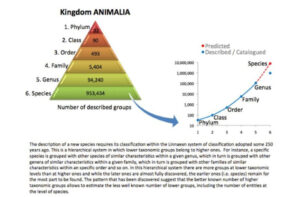In 1833, John Obadiah Westwood, a British entomologist, tried to guess how many species of insects there are on Earth. He extrapolated from England to Earth as a whole. “If we say 400,000, we shall, perhaps, not be very wide of the truth,” he wrote. Today, scientists have found over a million species of insects and keep finding more every year.
The question of how many species there are on Earth has been a tricky one ever since Westwood’s day. I’ve written a story for the New York Times about a new estimate that was published today: 8.7 million.
What makes the paper particularly interesting is that it introduces a new method for estimating biodiversity. The method is based on Linnean taxonomy. While we have lots of new species left to find, we may have found most of the classes, orders, and phyla. It turns out that for a number of groups–mammals, birds, and so on–the numbers of each of these rankings rise as you descend the hierarchy.
Here’s a diagram that summarizes this striking pattern (courtesy of the Census of Marine Life). I couldn’t fit it into the story, so I thought I’d show it here:

The scientists reasoned that we’re probably closer to having found most kingdoms, classes, and other high level groups. So they used this relationship to estimate how many species there are in well-studied groups like mammals and birds. They found this method got them a number close to the actual number of species. So they applied to other groups, such as plants and fungi.
As I write in the article, some experts love this method, and some don’t think much of it. I couldn’t get into deep details in a 1,000 word piece. Here’s part of a long email I got from Lucas Joppa, an ecologist at Microsoft Research in Cambridge, England. Joppa thinks the new method is important and intriguing. And he added some interesting thoughts about why knowing this number matters–aside from just being a very basic question that’s worth answering because we can–
I do think that it matters that we try to estimate this number, although given that we are talking about millions, I don’t really think it changes our daily perception of how many species there are (the human mind has problems with any number larger than a few hundred!). Moreover, I’m not quite so sure it matters if we are able to put an exact figure of how many species there really are, as when you look at the scope of the problem (2 million currently described, likely 7 million more!) it is unlikely that we will ever reach a full census of life on earth.
That said, the goal of coming up with a sensible estimate is not only noble, but worthy from a conservation perspective…the species currently unknown to science (at least in a terrestrial sense for well-known groups such as flowering plants) are likely to have ecological traits that are correlated with extinction risk (small ranges, rare within those ranges, etc.). Because of this, putting a number on the total number of species gives us insight into the number of missing species, and thus insight into the increase in the estimated numbers of species threatened with extinction around the world. In a recent paper in the Proceedings of the National Academy of Sciences, Stuart Pimm and I, along with collaborators, show that at least for one taxonomically important group (flowering plants), those species currently “missing” (ie, undiscovered) are most likely to be found in places that are already identified as global conservation priorities.
So, the good news is that even without having a full catalogue of life, the global conservation community is already actively engaged in protecting those places where species are most at risk (ie, Biodiversity Hotspots, locations with high number of species found nowhere else, but with extensive (>70%) of natural habitat loss). The bad news is that most new species will come from places around the world most at risk! As you can see from that direct example, while knowing every single species on earth is not a likely scenario, estimating information about those species, as Mora et al. do, can drastically change the way we view current estimates of species extinction risk around the world.
Originally published August 23, 2011. Copyright 2011 Carl Zimmer.